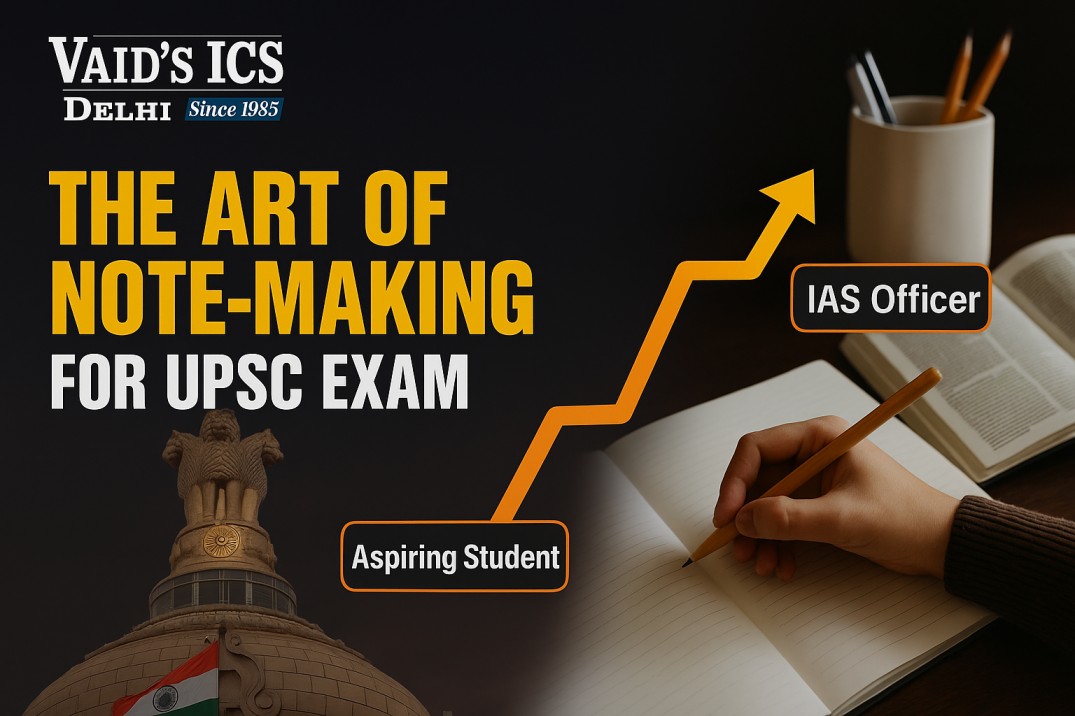Why Making Your Own Notes Is the Ultimate UPSC Game-Changer
In the vast ocean of UPSC prep, books and coaching materials are just maps. They show the path, but don’t walk it for you. It’s your own distilled , personalized notes that help you cross the finish line.
Note-making isn't a side activity or optional ritual. It's the critical bridge between mindlessly reading a textbook and actively crushing the answer writing—which, let's be honest, is all the UPSC Mains cares about..
There's a saying:"You remember what you have written, not what you have read."
Your notes become a mini syllabus-book—easy to revise, tailored to your understanding, and constantly evolving with current affairs.
The Benefits of Making Your Own Notes
- You Actually Remember Stuff: When you rewrite a concept in your own words, it sticks! It’s the difference between reading a foreign phrase and actually saying it.
- Sharpens Your Thinking: Summarizing, connecting ideas, and putting concepts into your own framework is the best possible answer-writing practice.
- Revision is a Breeze: A few pages of structured notes is way faster to scan than hauling a giant textbook off the shelf..
- Keeps You Up-to-Date: Got a new scheme or report? Just jot it down right next to the original concept. Easy.
Online vs. Offline Notes: What Works Best?
Both methods have their strengths. Here’s how to make each work for you:
Digital Note-Making Tips
- Tools: Stick to solid apps like Notion, Evernote, OneNote, or even a simple Google Doc.
- Keep It Short: Aim for around 450–500 words per major theme/topic. No one wants to scroll forever.
- Structure is Key: Use clear headings, bullet points, and a consistent color code for data, examples, and main concepts.
- Link, Don't Copy: Just drop a hyperlink to a long report or case study. Don't waste space pasting in paragraphs of text.
Offline Note-Making Tips
- Use Loose Sheets: Ditch the bound notebooks. Loose A4 sheets are much easier to file and rearrange.
- Keep It Tidy: Limit each topic to 1.5–4 pages max. Space out your text.
- Leave Breathing Room: Create wide margins (maybe about one-sixth of the page) on both sides. This is your space for last-minute updates and current affairs notes.
- Color Code: Use two colors—one for your core, static concepts and another for all those crucial updates, quotes, and value-adds.
- Stay Organized: File everything by subject: GS-I, GS-II, Optional, and so on.
The Daily Note Revision Habit (Highly Underrated)
Want to make your notes truly unbeatable? Adopt the simple 20-Minute Rule:
Spend just 20 minutes every day reviewing any section of your notes, even if it's random. This isn't about perfectly following a sequence; it's about consistency. Just make it a daily ritual, not a chore! That daily repetition supercharges your recall and starts building those powerful mental connections between topics.
How to Make Notes: A Step-by-Step System
- Read: Start with NCERTs, standard texts, or coaching materials.
- Highlight: Pinpoint the core elements—key definitions, essential data, names of scholars, or committee reports.
- Condense: Rewrite the content in your own words. Be ruthless about those word/page limits.
- Structure: Organize it logically. A good flow is: Definition → Dimensions → Case Study → Current Link.
- Refine: Go through your notes monthly. Add new schemes, recent examples, and the latest news.
Example: What Good Notes Look Like (GS Paper I - Urbanization)
Urbanization & Associated Problems
Total Length: ~3 pages
(1 for concepts, 1 for problems, 1 for solutions)
Structure Sample:
Definition & Context
Urbanization = Increase in urban population. (Census 2011: 31.2%)
Causes
- Push factors: rural distress, fragmented farms
- Pull factors: jobs, education, urban infrastructure
Challenges
- Urban sprawl → Unregulated housing
- Waste crisis → Swachh Survekshan 2025 insights
- Water stress → Chennai (2019) case
- Pollution → Delhi AQI consistently 400+
4. Government Schemes
- Smart Cities Mission (2015)
- AMRUT 2.0
- PM Awas Yojana (Urban)
5. Way Forward
- Integrated land-use planning
- Strengthen municipal finances
- Develop tier-2 cities
Sample Note : https://vaidsics.com/file-uploads/Vaids-ICS-Sample-Notes.pdf
Art and culture (Garima Lohia , AIR-2 , GS-1 ) :https://vaidsics.com/file-uploads/Vaids-ICS-Art-Culture-Notes.pdf
Geography notes (Anirudh , AIR 08 ) :https://vaidsics.com/file-uploads/Vaids-ICS-Geography-Notes.pdf
Ideal Note-Making Plan: 4 Stages to Follow
Final Takeaway
Look, there’s no single, magic formula for UPSC prep, but a great set of personalized notes comes pretty close. Whether you're a pen-and-paper traditionalist or a digital dashboard guru, your notes have one job: to give you lightning-fast recall and help you write amazing answers when you're under pressure.
Start small, revise daily, and treat those notes like gold. They're your personal UPSC asset, and they'll pay you back in marks!






